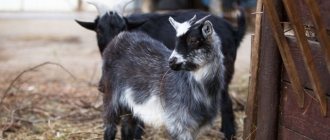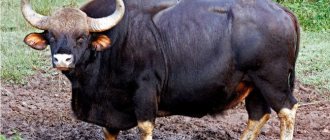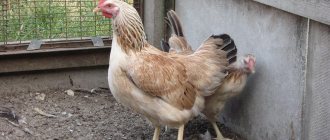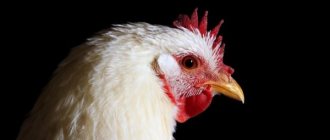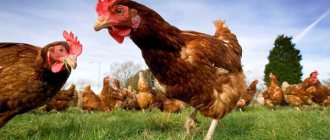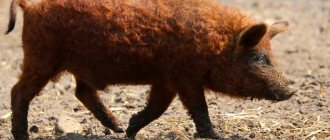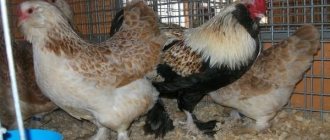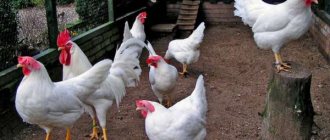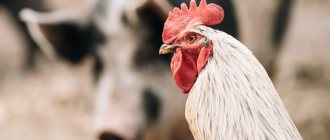Pros and cons of the Brama breed
pros
- Great dual purpose chicken.
- Very friendly with children.
- Huge size and unique appearance.
- Lays eggs all winter.
Minuses
- It may take 7 months before installation begins.
- He eats a lot, so the food bill is higher than for other breeds.
- When they are hungry, they can intimidate their pack mates.
Price
Purebred birds can be purchased at specialized breeding farms or from private breeders. Brahmas are considered common hens, so finding young or hatching eggs is not difficult.
Before purchasing, you need to check all the necessary certificates to avoid an outbreak on your farm. The average price for eggs for incubation is 150 rubles, reared young animals cost a little more - from 300 rubles. Breeding roosters with quality characteristics of the breed are the most expensive; their price tag starts from 1000 rubles.
History of the breed
Brahma was first developed in the 1800s in China. The name Brahma comes from the Brahmaputra River in India.
Until the 1930s, Brahmas were one of the most popular chickens for meat due to their size. However, as industrial agriculture has grown, Brahmas have become an unfavorable species to breed as they can take up to two years to reach maturity.
Breeds that matured faster became more profitable for meat. Brahmas are steadily gaining popularity again, this time as backyard pets.
Nutrition
The content of various substances (proteins, fats, carbohydrates, mineral and vitamin supplements) is vital for any chicken. The bird should receive food in various combinations and types: grain mixture, wet mash, kitchen waste, garden waste. Calcium-rich mineral supplements must be present in the diet. It is better to place them in a separate feeder, just like coarse sand or gravel. They must be constantly available to the bird.
When keeping Brahma chickens, there are foods that should be avoided, for example, boiled potatoes. It is not over-poisoned, but begins to ferment in the bird’s stomach, as a result the young animals begin to get sick. It is advisable to regularly mix coarse river sand, broken egg shells, shells, fish oil, and chalk with food. If possible, it is advisable to add soybean meal; it contains about 50% protein.
Food is given to the bird three times a day, preferably at the same time. The first feeding is a grain mixture, the second is wet mash, the third is grain. It is allowed to sprinkle 10% of the daily grain norm on the litter, thus increasing the motor activity of the bird when kept indoors in an aviary.
Breed varieties
In the description, Brahma chickens are classified as Asian chickens. The breed is classified according to its distinctive feather patterns:
- Light Brahma, white with a gray tint. They have black stripes on their saddle feathers. They were first officially recognized in 1865.
- Dark Brahma has noticeable differences between male and female. The male has a black body, chest and tail. Its feathers and saddle are striped black and white. The female has a gray body, chest, back and wings. It is covered with white and light gray shade. They were also first recognized in 1865.
- Buff Brahma has the same pattern as Light Brahma, except its color is a pale orange-brown. It was first recognized in 1924.
- The partridge breed of Brahma chickens has a strong build. The lush, dense plumage of these domestic birds creates a collar around the neck of a contrasting color compared to the main body color.
Although other Brahma colors existed, none remained popular enough to continue breeding or be officially recognized.
There is a small variety of bantam Brahma chickens. They come in five different feather patterns: light, dark, tan, black and white.
Appearance characteristics
Large, high-set body with a clearly defined meat constitution, wide chest and belly. Cockerels have a very small, pod-shaped comb, almost not divided by serrations. The chicken heads did not even receive such decoration. The eyes of the birds are orange-red, the paws are closer to a yellow tint.
Brahma's plumage cannot be confused with other chicken varieties. It comes in two types - light and dark, but all males of the breed are decorated with a contrasting collar. Accordingly, for white birds it will be black, for black birds it will be the opposite.
Since the hybrid was planned for keeping in areas with cold climates, the emphasis was on good thick feathers. The result is a chicken outfit with unusual shaggy pants, which gives the look an exotic appearance and a feature that cannot be confused with anything when identifying the breed. All the characteristics of the exterior together give the bird a regal appearance, full of dignity. Even the chickens walk slowly, as if they don’t want to spoil the impression of their own greatness.
Purchasing a breed
Brahma chickens are sold by breeders and companies across the country, and as these friendly giants become more and more in demand as more light is shed on this amazing breed, you will have no question where to buy Brahma chickens.
As with any other breed of chicken, it is important to ensure that you are purchasing from a reputable breeder/seller to ensure a healthy chicken. Buying chicken is available as an egg or as a hatched chick.
Diseases
Despite its strong immunity, the breed is susceptible to a number of diseases:
- Helminthiasis. The invasive type of disease occurs when worm eggs enter the digestive tract of a bird. Treatment is carried out with anthelmintic medications. Deworming is recommended every 3 months.
- Scabies mite. The parasite penetrates under the scaly plates located on the bird’s feet and into the feather follicles. The disease is accompanied by an aggressive condition, itching leads to partial or complete loss of feathers. Drug therapy includes the use of acaricidal drugs.
- Period. The disease provokes the development of itching. The skin parasite can be seen on the body with the naked eye. For treatment, insecticides designed to combat ticks and fleas are used.
- Neuritis. The causative agent of this pathology is considered to be the herpes virus. The disease can occur in classical and acute forms. Type 1 is characterized by paresis, lameness, and paralysis. For form 2 - exhaustion, decreased egg production and tremor. The virus is stable in the external environment; there is no specific treatment.
- Leukemia. An oncological disease characterized by necrosis of the ridge, exhaustion and decreased egg production. A tumor forms under the skin in the chest area.
- Coccidiosis. A parasitic infection caused by a protozoan organism. Chickens are at risk. The incubation period of the pathology is 4-5 days. Symptoms: loss of appetite, depression, thirst, unkempt appearance (bald spots, drooping wings). Drug therapy includes taking coccidiostats.
- SSYA-76. A viral type pathology that affects the genitals of laying hens. The female's body is not able to form an egg - the shell becomes soft. There are no characteristic signs. Associated symptoms include diarrhea and prostration.
- Pasteurellosis. Infectious diseases cause sudden death in chickens. If the disease is acute, the individual’s earrings and comb turn blue. The pectoral muscles completely atrophy, foam appears from the beak. The bird is thirsty. Chronic pasteurellosis is accompanied by rhinitis and inflammation of the jaw.
- Salmonellosis. The main manifestation of the pathology is liquid, foamy droppings. The bird becomes lethargic and experiences extreme thirst. Possible swelling. Chickens are at risk.
- Listeriosis. The causative agent is a gram-positive rod. Characteristic manifestations of the pathology are convulsions and conjunctivitis. If left untreated, the bird becomes paralyzed and dies.
Any ailments or changes in behavior are a reason to contact a veterinary clinic. A number of pathologies cannot be detected without laboratory testing.
Appearance
In the photo of Brahma chickens you can see their distinctive feature - a tall and wide body of large size. They have feathers on their shins and toes.
- Brahma has a pea-shaped comb and a short but strong beak.
- Their head is wide and their forehead hangs over their eyes, the so-called “bug eyebrow”.
- They have dense plumage with a thick layer of down, making them a suitable breed for colder climates.
What to feed
Feeding Brahm does not differ in any special ways. It is necessary to give the birds grain, combining it with mash, vegetables, and chopped grass. Brahma must have constant access to clean water. The water needs to be changed frequently - at least once a day. To improve egg production in winter, birds need additional vitamins.
Don’t forget to provide the birds with river sand and fine gravel. It provides chickens with the opportunity for proper digestion. Brams are no exception.
Important! Brahma chickens need to add a new portion of feed, provided that the previous portion is eaten completely! Birds are prone to obesity and may stop laying eggs.
It is better to feed three times a day. In the morning and evening - grain, in between - mash, chopped grass and potatoes.
How big are eggs
Brahma hens are considered very good winter layers of large brown eggs weighing approximately 55-65g.
- The egg production of Brahma chickens averages 2-3 large eggs every week, which gives approximately 120 eggs per year.
- Unlike many other breeds, they happily lay eggs all year round, including winter!
Breeding Features
For breeding, it is recommended to buy individuals from one to 3 years old. Chickens reach sexual maturity at 9 months of age. Around this time, the hen instinct awakens in birds. It is especially developed in light-colored representatives of the breeds. They hatch eggs well and carefully take care of their offspring.
The hen should be planted or the eggs should be incubated from mid-February to April. During this period, hatched chicks will have time to become sufficiently strong, fledge for winter and calmly endure low temperatures.
After birth, Brahma chickens need a heated and well-lit room and fortified food. For chicks up to 2 weeks old, broiler starter feed is suitable.
Conditions of detention
Brahma is a large bird, so they need more space than the average chicken.
We recommend 1.5-2 square meters for each Brahma chicken in the coop.
Don't go below this value as less space leads to anti-social behavior such as pecking and feather plucking.
- As for roosting space, give them about 15-20cm per hen.
- If you make the perches too high, you risk injury to your leg or foot when they come down from the perch.
They will tolerate confinement as long as they have enough space in the pen. Each of these gentle giants needs 4-5 square meters. Ideally, the pen area should be stone or sand. Paws become dirty very quickly due to a dirty floor.
This breed thrives on freedom, so try to let them roam freely - they will enjoy the freedom and variety.
Temperament
Brahmas are known to be very friendly and approachable chickens. They are calm and gentle. This makes them very easy to handle. They make excellent backyard pets, including those with children.
Health
Brahmas usually do not have health problems. You will need to pay attention to your Brahma's feet because of the feathers on their feet and toes.
- If the feathers become dirty with dirt or feces and are not cleaned for a long time, the chicken may lose nails or toes.
- Wet toe feathers in colder climates also put the chicken at risk of frostbite.
- For these reasons, Brams are better suited to drier locations with well-drained soil.
- Toe feathers sometimes break off and bleed. If this happens, apply pressure and then apply a small amount of cornstarch to the area.
Because their plumage is dense, it can be difficult to spot ticks or lice. Check regularly for symptoms.
Origin
The formation of the breed took place over a long period of time. It is believed that it was originally created by crossing Cochin and Malayan chickens in Southeast Asia. In the mid-19th century, “Shanghai birds” began to be exported to England and America, where breeders did a lot of work to improve meat qualities, and in 1874 the breed was officially registered in the USA. European poultry farmers focused on aesthetic aspects and created a decorative subtype. Therefore, brahm in different countries is classified as both a meat and a decorative product.
Adults reach a live weight of up to 4-5 kg (hens and roosters, respectively)
“Brama” was registered in the Russian State Register in 1993 as an ornamental breed, approved for cultivation in all regions of the country. Birds are well adapted to various climatic conditions and are quite resistant to most common diseases.
Summary
Because of their friendly nature and ease of handling, Brahma chickens make excellent pets. Most Brahmas can be bred with other breeds of chickens without any problems.
They can be kept behind a low 60-90 centimeter fence, as they do not fly well. This is a quiet breed, even the males do not scream particularly loudly.
Because they are large birds, Brahms will need an appropriately sized coop with larger nesting boxes, taller doorways, and sturdy roosting poles. Because of their size, they tend to eat more than other breeds, so food bills may be higher.
Diseases
Brahma has a fairly strong immune system, but this does not mean that the chicken does not need to be taken care of. In order to prevent a number of diseases, farmers recommend:
- Disinfect the premises once every 6 months. It will clear the chicken coop of ticks, fleas and other pests that can cause serious damage to the chickens.
- To prevent chickens from being infested by parasites, you need to install containers with wood ash in the chicken coop and in the yard, where the chickens can periodically “bathe”.
- In order to protect chickens from colds, chickens are vaccinated against bird flu at the age of several days.
- To improve immunity, chickens are given a weak solution of potassium permanganate or water with antibiotics diluted in it.
- To prevent a disease such as rickets, which often occurs in heavy breeds, chickens are given fish oil or fish waste at least once a week.
- The room in which the bird lives should be dry and well ventilated, but without drafts. To protect the room from dampness, a bedding made of suitable materials is laid on the floor: hay, straw, peat, sand, sawdust, etc.

